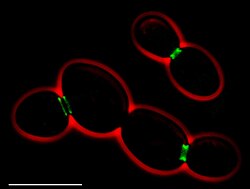
• Green: septins (AgSEP7-GFP)
• Red: cell outline (phase contrast)
• Scale bar: 10 μm
A septum in cell biology is the new cell wall that forms between two daughter cells as a result of cell division.[1]
In yeast, septins form a ring structure, to which other proteins are recruited.[2] In particular, chitin synthase 2 is required, an enzyme that synthesises chitin thereby building up the primary septum. A secondary septum of β-glucans and mannoproteins is then assembled using the enzyme 1,3-Beta-glucan synthase, and the primary septum degraded during cell separation. After degradation of the primary septum, a chitinous bud scar remains on both the mother and daughter cell. [2][3]
- ^ O'Connor C (2008). "Cell Division: Stages of Mitosis". Nature Education. 1 (1): 188.
- ^ a b Cabib E, Roh DH, Schmidt M, Crotti LB, Varma A (June 2001). "The yeast cell wall and septum as paradigms of cell growth and morphogenesis". The Journal of Biological Chemistry. 276 (23): 19679–82. doi:10.1074/jbc.R000031200. PMID 11309404.
- ^ Lesage G, Bussey H (June 2006). "Cell wall assembly in Saccharomyces cerevisiae". Microbiology and Molecular Biology Reviews. 70 (2): 317–43. doi:10.1128/MMBR.00038-05. PMC 1489534. PMID 16760306.